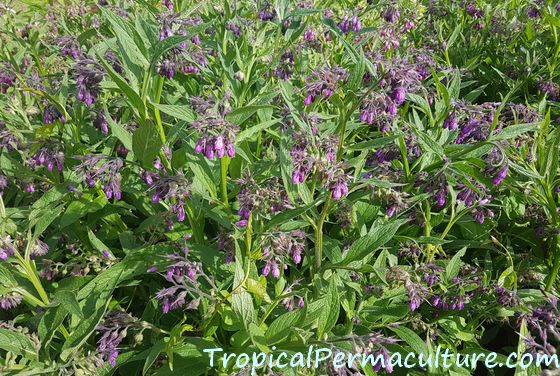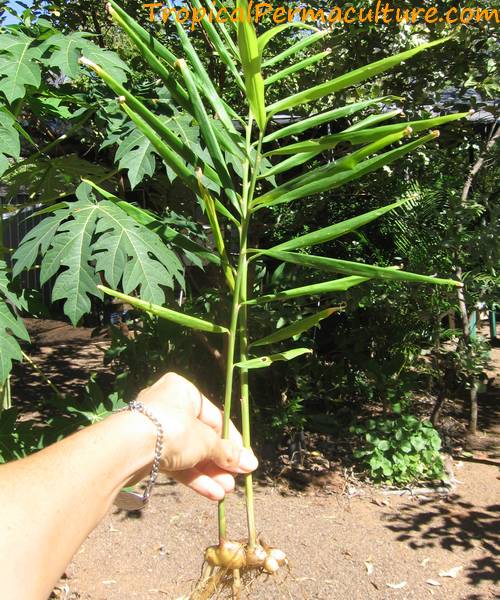Growing Lettuce (Lactuca Sativa)
How To Grow Lettuce In Warm Weather
Growing lettuce is relatively easy. Well, as long as it is cool enough.
Unfortunately lettuce is NOT a tropical plant! In the tropics you can only grow lettuce during the cooler months. Lettuce does NOT like hot weather.
But I come from a cooler climate originally. I do love my lettuce and grow it every year and that's why tips for growing lettuce are included here.
I don't just love eating lettuce, I also love to grow lettuce. Lettuces are so pretty!
I have a whole collection of varieties. Big round leaves and small frilly ones, dark red and light red, green and freckled, wide leaves, narrow leaves, oak leaves...
You name it, I grow it.
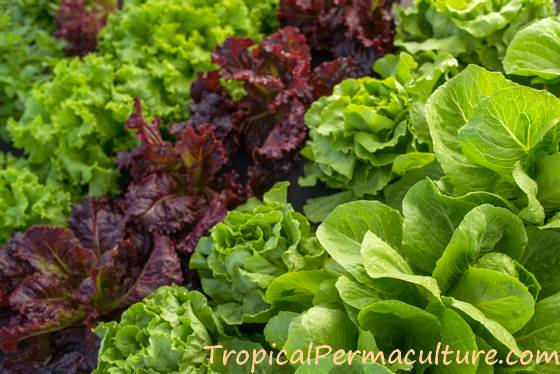
Did you know...
- The earliest mention of lettuce in history is a carving on an Egyptian temple. Lettuce was considered an aphrodisiac in Egypt.
- The Greeks used lettuce as a medicinal plant to induce sleep.
- The Romans also grew lettuce. They cultivated a narrow leafed Cos/Romaine type lettuce, much like today's "Rabbit Ear" lettuce.
- As so many other crops, lettuce was brought to us by Christopher Columbus.
- The name lettuce and the botanical name Lactuca come from the Latin word lac. It means milk and refers to the milky sap inside lettuce leaves and stems.
- Lactucarium is an opiate-like substance found in the milk of lettuce. It is also called Lettuce Opium. Supposedly it helps to induce sleep. And in my experience it does.
- In some Asian countries lettuce is used as a cooked vegetable. Both the stem and leaves are used. There are even varieties of lettuce that are grown for the stem rather than the leaf.
(I grew that once, out of curiosity. The seed company called it "stem lettuce". It is also known as "celtuce".)
Why You Should Grow Lettuce
Have you ever tasted a lettuce fresh from the garden? I mean, FRESH? Picked less than 30 minutes ago? It's amazingly delicious! You will never settle for shop lettuce again after you tasted a truly fresh garden lettuce.
When I still worked outside the house I used to pick a big bowl of lettuce every evening. Half I ate for dinner (yum!), and the other half I kept to make lunch at work the next day.
I neither washed nor chopped the leaves. I just put them in the fridge in a sealed bag to take to work the next day. When I ate it, the lettuce had been picked less than 24 hours ago and already it tasted bland compared to my evening meal.
The flavour still beats the shop lettuces any day, but it's definitely not the same as a garden fresh lettuce. That's one reason to grow lettuce.
(Lettuce also tops the list of vegetables that have the most pesticide residues on them, but I assume you are smart enough to buy organic anyway, right?)
The other reason to grow lettuce is that lettuces are so incredibly ornamental. You know I don't believe in the separation of a strictly defined "veggie patch", kept separate from the ornamental part of the garden.
(If you don't know what I'm talking about, read my article about Permaculture Zones.)
Do you know how many colourful varieties with different kinds of leaves there are?
You can plant the most beautiful swirls and patterns just out of lettuce!
But even individual plants or clumps of a few, strategically placed, can look as gorgeous as any typical bedding flower.
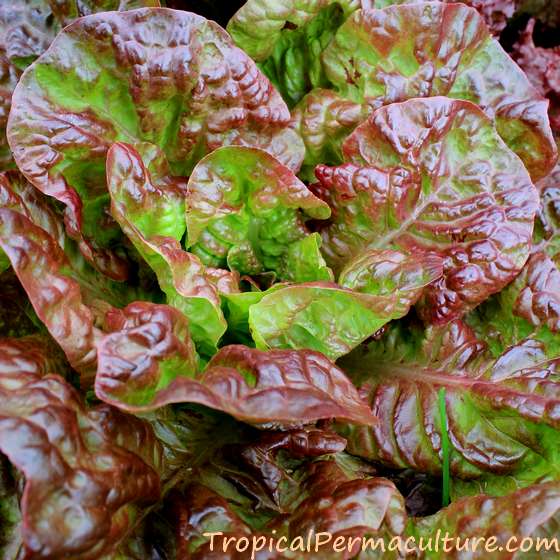
So lets finally get into growing the stuff!
Growing Lettuce
What Lettuces Like And Dislike
- Lettuces need good soil. It should be light, free draining and rich in organic matter. It needs to hold lots of water and lots of nitrogen and other nutrients.
- Lettuces taste best when they are grown as fast as possible and for that they need water and food.
- Lettuces need lots of everything, and they want a steady supply of it. Any set back they suffer will at least make them tough and bitter, at worst it will cause them to bolt to seed straight away without making any leaves for you! So make sure they never get stressed (e.g. by forgetting to water them).
- Lettuce has shallow roots, so it dries out easily!
- Any gardening book (all written for cooler climates) will tell you that full sun is essential. Full sun is best ONLY when it isn't too hot. Once the temperatures approach the thirties (climb above 80 F, if you think in Fahrenheit), your lettuce will definitely appreciate some shade!
Growing Lettuce From Seed
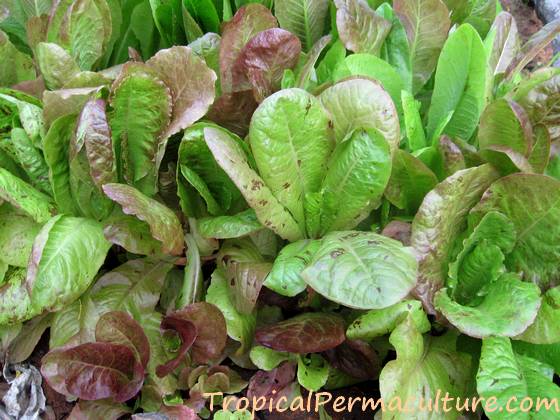
Direct seeding is the easiest way to grow lettuce.
Either spread the seed very thinly along a row and cover lightly with soil, or sprinkle it over a bed and rake it in. Lettuce seed is very fine and not easy to spread evenly, therefore both methods will likely require you to thin your seedlings later. (But if you wait long enough you can eat the thinnings as baby lettuce.)
Lettuce seeds usually germinate within seven to ten days but can take as little as two or as long as twelve days. It depends on the variety, the temperature, the moisture and other factors.
To thin your seedlings if they are too dense, cut the surplus lettuce plants rather than pulling them out, so you don't damage the roots of the neighbouring plants.
Direct seeding will likely cause some losses. Emerging lettuce seedlings are very vulnerable to all sorts of bugs. Slugs love them, so do grass and leaf hoppers, and earwigs and other soil insects can get them before they even break the surface. Also, lettuces grow very slowly in the beginning and are easily overgrown by weeds.
You can also grow your lettuces in pots or punnets and transplant them when they are big enough to handle.
Handle them very carefully to minimize the transplanting shock. Ideally you don't disturb the roots at all. (For that reason punnets or planting trays with individual slots are preferable to pots.)
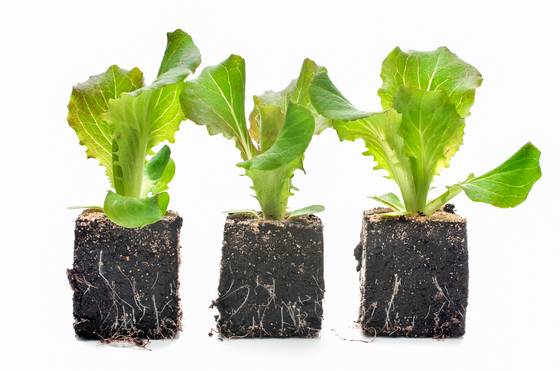
Only transplant lettuce in the late afternoon to give them the longest possible time to settle in, before they have to cope with the sun and heat.
If your lettuce seedlings were grown in shade or semi shade you need to sun harden them before transplanting them.
Alternatively you can provide shade for a few days in their new position and then gradually remove it. (A couple of hours the first day, longer the next and so on.) If it's very hot, you may need to do both.
The cooler the weather, the better your chances to successfully transplant your lettuce.
I ALWAYS direct seed. In this climate it's easier.
Growing Lettuce Plants
Lettuces need to grow fast to taste good, so keep up the water and nutrients. If the weather is very hot and your soil sandy, you will need to water daily. Stick your finger in the soil if not sure. Lettuces have a very shallow root system, so if your finger does not find any water, neither does the lettuce!
If your lettuce grows slowly despite having plenty of water, then it needs more food. Ideally you planted your lettuce in a well prepared bed that has lost of organic matter and compost in it. If not, then you need to supply extra nutrients, especially nitrogen. The problem is that too much added nitrogen makes plants sappy and weak and very attractive to bugs. Therefore repeated small doses of fertilizer are better than one big dose.
(A classic high nitrogen fertiliser would be chicken manure.)
Lettuces need some shade in hot weather. Don't plant them in deep shade though, like under a tree. They will just grow into pale, leggy things with few leaves on them. Ideally you find a position that provides dappled shade in the afternoon. Other options are interplanting between taller plants that will not totally shade them (capsicums/peppers or eggplants, staked tomatoes).
Growing lettuce in a patch of coriander/cilantro works well for me. Cilantro is even more heat sensitive than lettuce. It bolts to seed first and the fine leaves and flower heads shade the lettuce just enough to allow it to hang in there.
(This will not work for everyone. It depends on your climate and what lettuce variety you grow. But take the idea and experiment with it!)
If you get surprised by a heat wave, you can always cut a leafy branch somewhere and poke it in the ground next to your lettuce.
Harvesting Lettuce
You can start harvesting loose leaf lettuces (like cos or oakleaf varieties) only two to three weeks after they germinate. At that time they'll be only microgreen size, but hey, it's a start. Carefully remove a few outer leaves as you need them. You can also remove whole plants by cutting them at soil level if your lettuces are growing too densely.
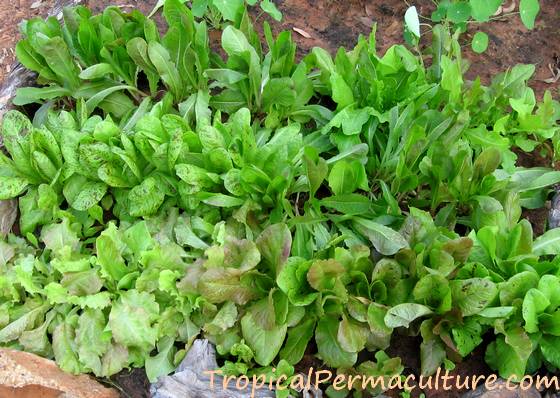
Initially your harvest won't amount to more than a sandwich topping, but soon enough you'll have enough for your first salad bowl. You can continue harvesting your lettuce like that for many weeks.
After about eight weeks the leaves will have reached their mature size. If you do not harvest the outer leaves now, then the plant will start to elongate and develop a seed stem at which point it will start to taste bitter. But keep picking the outer leaves and you can delay this "bolting to seed". Of course, this also depends on the temperature. Once it gets too hot, nothing will stop your lettuce from seeding.
I don't recommend growing hearting lettuce varieties in hot climates, but if you want to try anyway, or if you live in a cooler climate, then you will have to wait for ten to twelve weeks for Romaine varieties and up to 15 weeks for crisphead varieties to mature. Naturally, you then harvest these lettuces by cutting the whole plant.
Again, once the head starts to elongate to form a seed stem the leaves will turn bitter, so don't leave it too late just because you are hoping for a bigger head still.
I personally can't think of a good reason to grow hearting varieties. To me the looseleaf varieties have too many advantages.
Problems When Growing Lettuce
Nearly all problems you may encounter when growing lettuce are caused by hot weather. The most common problem, apart form the plants bolting to seed prematurely, are brown edges on the leaves. This happens especially if you get very hot weather after a cool spell.
I already mentioned above that slugs and snails love lettuce. But if the lettuce grows fast enough, they shouldn't do much damage. Slugs are mostly a problem when the plants are still small.
Bugs that chew on your lettuce are often a symptom that your plant is not as happy as it could be. Bugs are attracted to stressed plants. So in the end it comes down to everything that I explained above. Enough water, enough nutrients, just the right amount of shade, and... Accepting that lettuce is not a tropical vegetable!
Some More Tips For Growing Lettuce In Hot Weather
Not all kinds of lettuce are created equal! Sorry, Iceberg is out. Do not bother with it. In a tropical climate it will just rot from the centre.
The other hearting lettuce varieties, like Butterhead or Batavian (Summer Crisp) may do ok in the coolest months. (The upper temperature limit to grow heading lettuces is 28°C/83F)
Unfortunately the Cos/Romaine types (my favourite) are also very heat susceptible. I do grow those but they are the first to bolt to seed at the first sign of hot weather.
The most heat tolerant kinds of lettuce are the open leafed varieties. All the pretty fancy lettuces you see in the shops, the frilly and curly varieties, they are your lettuce varieties of choice for hot weather.
There are also differences in the heat tolerance of the open leafed lettuce kinds.
Darker lettuce absorbs more sunlight than lighter colours, so it suffers sooner (but they are prettier). Choose light green over dark red.
The most heat resistant kinds of lettuce in my experience are the oakleaf varieties.
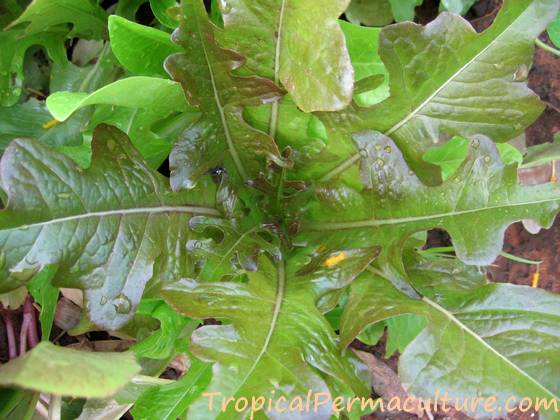
Here in Australia we have a green oakleaf lettuce called Darwin, named after Australia's most tropical city. It is by far the hardiest lettuce I know, but any light green oakleaf variety does well in my garden.
Growers in other parts have different experiences. Lettuce is a crop that you need to experiment with yourself to see which varieties are happiest in your garden. And why not? Experimenting with lettuce is fun and rewarding!
If I grew lettuce only for eating, I'd grow just my Darwin lettuce. But lettuces are waaaay too pretty to limit myself to that.
I grow a lot of the green oakleaf as my staple, and I grow all others for their ornamental value. My favourite kind of lettuce to grow is a light green Cos or Romaine type with pink, red or purple dots, called "Freckles" :-).
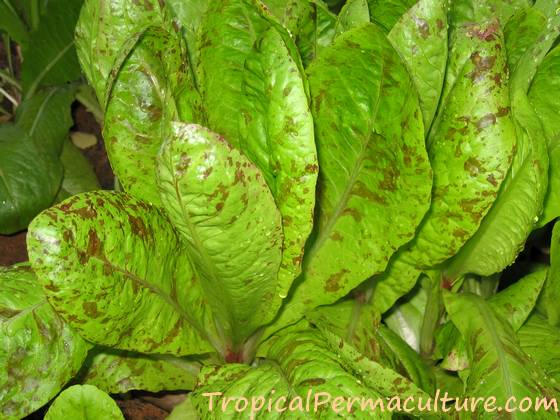
You can always buy a packet of mixed seeds, and then save the seeds from those varieties that lasted the longest before flowering.
Lettuce flowers mostly self pollinate. If you grow several varieties next to each other you will end up with about 95% of seed that is just like the parent, and 5% of surprises. And you never know, one of those surprises may be even more heat tolerant!
Just save the best seed every year, and within a few years you have the most heat tolerant lettuce, perfectly adapted to grow in your garden, something you'd never be able to buy.
